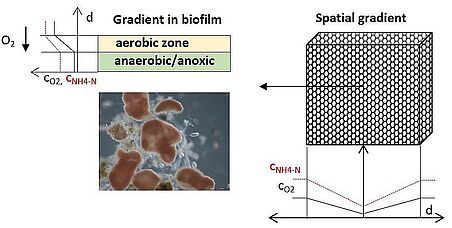Linpor-HD
Mainstream deammonification with Linpor® carriers as IFAS process
Duration:
01.2019 - 12.2021
Financing:
Österreichische Forschungsförderungsgesellschaft FFG, STRABAG AG
Contact Person:
Jörg Krampe (![]() jkrampe(at)iwag.tuwien.ac.at)
jkrampe(at)iwag.tuwien.ac.at)
Project Staff:
H. Jagenteufel, V. Parravicini
Partner:
STRABAG AG (Link)
short description
Anammox bacteria convert ammonium and nitrite into elemental nitrogen gas without the presence of oxygen. During this process, there is no need for organic carbon. The independence from carbon availability therefore makes the mainstream deammonification interesting for technologies that focus a targeted COD removal (for example micro-sieves) and an increased energy production (biogas production).
The purpose of this study is to test a method that allows the retention of slow-growing anammox bacteria by the use of carrier materials in the biological stage of WWTP.
For this purpose, the investigation focus an IFAS process (integrated fixed film activated sludge) to develop a mainstream deammonification. The detailed investigation of the process with the evaluation of the cleaning performance and operational stability will be carried out in an already existing pilot plant of the Institute for Water Quality and Resource Management (TU Wien). As part of the experiments, the aerated tank of the pilot plant will be filled with LINPOR® carrier material (STRABAG AG). The aim is to ensure a high sludge age for the accumulation of anammox bacteria. The three-dimensional structure of the cubes favors the formation of spatial substrate and oxygen gradients (Figure 1). In this regard, the spatial structure is probable more suitable to ensure the simultaneous accumulation of the anammox organisms and ammonium oxidizing bacteria than previously used two-dimensional growth carriers. The growth of the anammox bacteria on the carrier material has the further advantage that the sludge age of the suspended biomass is decoupled from the sludge age of the anammox biomass in the biofilm. This operation strategy allows the construction of smaller WWTP and offers thus additional saving potentials with regard to the investment costs.



